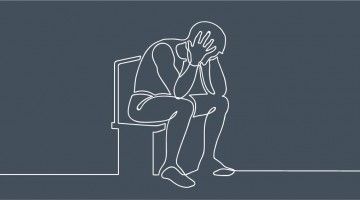Plain-language summaries
Institute for Work & Health (IWH) plain-language summaries condense research findings in various formats. At Work articles explain study results with comments from the study leads. Research Highlights summarize journal articles in easy-to-read, digest formats. Sharing Best Evidence summaries highlight findings from systematic reviews and other types of reviews conducted or led by IWH researchers. Issue Briefings discuss key research findings from IWH or elsewhere on topics that are of particular interest to policy-makers.

Research Highlights
Workers’ and managers’ perspectives on workplace supports for depression
In a survey of workers with depression and those who manage them, nearly one out of four said no supports were available. Asked about the most helpful type of support, survey respondents with lived experience of depression most often indicated employee assistance programs (EAPs) and other supports external to the workplace. As for barriers to implementing practices, participants noted unsupportive managers, lack of knowledge about mental health in the workplace, and lack of training for managers.
Published:

At Work article
What research can do: Scanning how OHS authorities responded to the pandemic
A policy briefing by IWH finds common challenges in the way labour inspection authorities in different jurisdictions addressed the pandemic
Published:

At Work article
Study probes factors behind poorer health, lower employment in injured workers’ post-claim experience
New injured worker cohort study at IWH focuses on experiences of workers with long-duration claims of 12-plus months
Published:

At Work article
In most sectors, workplaces saw lower COVID transmission rates than in the community
Studies by Institute for Work & Health and Public Health Ontario also find layers of infection control measures adopted in vast majority of workplaces
Published:

Research Highlights
The economic benefits of a fully accessible and inclusive Canada
If Canada were a fully accessible and inclusive society, the economic benefits would amount to about $337.7 billion in calendar year 2017. This amount is equal to about 17.6 per cent of the gross domestic product in that year.
Published:

At Work article
For a segment of the workforce, psychosocial working conditions are poor across the board
IWH study finds risk of burnout, stress greatly increases for the 1 in 10 Canadian workers in consistently bad job environments
Published:

Issue Briefing
Response to COVID-19: Gathering experiences of OHS authorities in developed countries
In early 2021, a group of researchers led by IWH President Dr. Cameron Mustard asked authorities responsible for occupational health and safety (OHS) in developed countries how they had, to date, addressed the COVID-19 challenge. This Issue Briefing shares what the researchers learned.
Published:

At Work article
What research can do: Partnering on a tool to estimate occupational risks of COVID
Public Health Ontario and Institute for Work & Health collaborate to answer emerging research questions
Published:

At Work article
Inadequate employment standards, OHS vulnerability add to higher injury risks
IWH study finds injury risks increased five-fold when both types of work vulnerability were present
Published:

At Work article
COVID worries highest among workers with both physical, mental health disabilities
Greater concerns among workers with disabilities stem from their work conditions, not disability status
Published:

At Work article
Emerging evidence points to negative health effects of physical work demands
Findings on ‘physical activity paradox’ suggest need for more warm-ups, work breaks for labourers: scientist
Published:

At Work article
Unemployment benefits linked to lower mortality rates over 10 years: IWH study
Study finds jobless people with income support have 25 per cent lower death rates than those without
Published:

At Work article
Claim suppression study in B.C. finds under-claiming of work injury to be common
Joint study by Institute for Work & Health and Prism Economics and Analysis also finds employer pressure, inducement not to claim seen in four to 13 per cent of work injuries
Published:

At Work article
Education, type of work lessen pandemic job loss in youths with rheumatic diseases
Follow-up study finds employment dropped by 72 per cent when all factors are taken into account
Published:

At Work article
Weaker OHS procedures, policies explain small employers’ higher injury risks: study
No difference in injury risks between large, small firms once OHS policies, procedures accounted for
Published:

Issue Briefing
Nature and extent of claim suppression in B.C.’s workers’ compensation system
The Institute for Work & Health collaborated with Prism Economics and Analysis to conduct a study for WorkSafeBC on claim suppression in British Columbia. This Issue Briefing summarizes the findings of this study and compares them with the findings of previous Institute studies on claim suppression in Manitoba and Ontario, as well as with the findings of other research in Canada.
Published:

At Work article
Costs of providing UV ray protection at job sites outweighed by averted skin cancers
IWH economic analysis in Ontario finds net gain over 30 years when protective clothing, shade structures used to reduce skin cancer risk in construction workers
Published:

Research Highlights
Examining the link between leisure-time exercise and physically demanding work on diabetes risk
Workers in sedentary jobs who meet physical activity guidelines of at least 150 minutes a week have a 37 per cent lower chance of developing diabetes over 15 years, compared to people in the same types of jobs but who do less exercise. Meeting physical activity guidelines is less beneficial for people whose jobs involve movement or high physical demands (such as lifting heavy loads).
Published:

At Work article
Nine trends that will likely shape future of work for groups of vulnerable workers
IWH research team conducts ‘horizon scan’ to identify major changes to come, and what they may mean for people currently facing labour market barriers
Published:

At Work article
Having depression leads to lower earnings over 10 years: study
Study by IWH researcher finds 10-year earning loss amounts to $115,000 for men and $71,000 for women
Published: